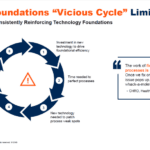
One of the biggest challenges companies across various sectors face is talent acquisition. The demand for highly qualified experts with in-depth domain knowledge, narrow expertise, and a traceable history of successful case studies greatly exceeds their availability on the market.
Generally, the more competitive a business domain is, the higher staff turnover rates are. Unsurprisingly, it’s high-performers who have the highest turnover rates: in 2022 47% of them left their companies. This leaves employers in a fierce competition for available top-tier talent. However, it is becoming increasingly more expensive and takes ever longer to find, hire and onboard an expert. In the US, the hiring period is 44 days on average, with C-level managerial positions sometimes taking several months to fill. Naturally, businesses are keen to foster loyalty and long-term, mutually beneficial partnerships with A-class experts.
Thus we arrive at a strategic dilemma: do we hire external experts or do we cultivate them within our own team?
Pros and Cons of Hiring A-Class Experts Externally
Finding a top-tier expert that fits a specific project or a set of tasks should generally be considered a force of great luck. However, it comes with its own set of advantages and drawbacks.
Pros of Hiring an External Top-Tier Expert:
-
Time Efficiency and Fresh Perspectives
Hiring external experts can quickly fill skill gaps in your expertise and drive immediate results. A new A-player can bring fresh ‘outside’ points of view which will further drive innovation, this can greatly add value to your processes.
-
Specialized Skill Sets
Many high-level tasks businesses have require very specific skill sets that are needed immediately. For instance, cybersecurity to protect customer data, or advanced analytics to interpret consumer behavior trends.
-
Scalability
Hiring an external expert can be a way to quickly scale and empower your team and boost its productivity шf you are working on a project that demands a quick expansion of your workforce.
Cons of Hiring an External Top-Tier Expert:
-
High Hiring and Retention Costs
Prospecting and hiring A-players is expensive. This includes potentially higher salaries demanded by top-tier talent and recruitment costs. At that, quite a few A-players prefer project-based partnership. Once their task is completed successfully, they are likely to hop on to the next challenging endeavor in another company.
-
Cultural misalignment
Cultural misalignment is a common problem when you are hiring a mature A-class expert. Experts who have developed their skills and professional identities in different organizational environments may find it challenging to adapt to new corporate values, work styles, and more junior level team dynamics.
-
Unpredictability
External hiring always comes with a certain risk. Even if a hire prospect has a proven track record of successful projects, it doesn’t mean that they will be a great match in your particular case and context. It is really hard to judge how well they will perform when you’re just starting out with them.
Challenges and Benefits of Nurturing Experts Internally
Training your own employees to become high-performers and A-players comes with its own set of advantages and drawbacks. Here are some of the most common:
Benefits of Training Top-Tier Experts In-house:
-
Cultural Fit and Loyalty
According to research, a staggering 94% of employees would stay longer, if their companies invested into their careers. Overall, recognition and appreciation are named as the top drivers of employee retention. When you invest in your employees’ education and career progress, you show your appreciation and raise experts that share your company’s values.
-
Reduced Turnover Costs
Nurturing your own talent, you create a more engaged and committed workforce with higher job satisfaction rates. This approach can significantly reduce attrition rates and turnover costs, as employees stay for career progression.
-
Scalability of your Learning Processes
If you have managed to train a high-performer, their experience and success can be digitized. You can turn it into actionable training materials and scale up and down across other departments.
-
Predictability
When your A-player is a person you have raised from junior or middle positions, you already know what to expect of them. You are aware of their strengths and weaknesses, can capitalize on the former and cover up for the latter.
-
Creating Unique Expertise
When an expert grows to the top-tier within your company, their knowledge about your domain and company specifics deepens and matures. Thus it becomes an invaluable source of expertise for your business and other employees.
Challenges of Training Top-Tier Experts In-house:
-
Time and Resource Consuming Process
Nurturing A-players internally is a long-term investment which requires substantial resources. It is never a sprint but rather a marathon, so you shouldn’t expect immediate results.
-
Potential Skill Gaps
Relying solely on internal talent development may lead to skill gaps within the organization. If the market evolves and new skills become crucial rapidly, the internal workforce may not be able to meet these needs quickly enough.
-
Creating a Dependency
A long-term collaboration with an A-player, especially someone who has grown within your company, can create a dependency on their expertise. If too much in a project hangs on the performance of a single person, you could be left with a huge gap in your workflows, should they decide to leave for any reason.
Best Practices for Top-Tier Expert Training
It is clear that today’s HR challenges highlight the need for a balanced approach in talent management, combining both internal development and strategic external hiring. We at iSpring have gone by the way of training our own top-performers, and in this process, we have formed several principles we’d like to share.
-
Digitize and Scale Your Successful Practices
One of the most effective ways to add value to your expert training and to raise the overall performance of your teams is to use your own successful experiences. Identify and analyze successful methods and strategies developed in your team.
-
Prioritize Soft Skills
Research shows that leaders with strong soft skills can boost their team’s performance by 30%, and training in communication and soft skills can deliver up to a 250% ROI.
-
Offer Cross-Functional Projects
According to Deloitte, 83% of companies that take leading positions in their domains use cross-functional collaboration of their teams. Expose your top-tier experts-to-be to cross-functional projects where they can work with experts in other areas of the business.
-
Find a Reliable LMS Partner
The organization of a learning process for training A-players in-house is not a trivial matter and requires a solid foundation and systemic approach. One of the best ways to host and organize your corporate training is to use a Learning Management System. A good LMS like iSpring Learn will offer you tools for career pathing, course creation and management, monitoring and control over your trainees’ progress, and learning material organization.
Key Takeaways:
Businesses struggle with the decision between hiring external A-class experts for immediate specialized skills and investing in the long-term growth of existing employees to cultivate similar expertise in-house. Although external hiring may be faster and bring in new perspectives, it is also expensive, unpredictable and most often temporary. It also comes with a high turnover due to the nature of tasks that require narrow expertise. Internal expert development promotes a good cultural fit and employee loyalty and can become a source of motivation for many employees. Overall, it all comes down to finding a perfect balance between your business goals and a blended learning strategy to optimize talent management effectively.



